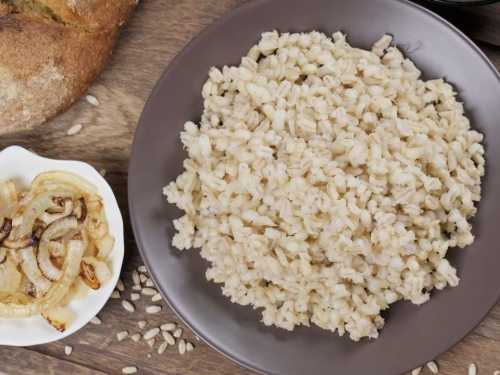
Pearl barley is indeed a very useful and underrated cereal that deserves a place in the diet. Its benefits lie in its balanced composition of nutrients. We talk about its beneficial properties and share life hacks for cooking – so that pearl barley porridge turns out crumbly.
What do pearl barley and pearls have in common?
Pearl barley is barley that has been hulled and polished. The grains are light and oblong, with a smooth, shiny surface. This is how the grain got its name, which comes from the French word “perle,” meaning “pearl.”
Types of pearl barley
There are several types of barley groats. Pearl barley itself varies in shape and processing method.
Whole-grain pearl barley is the healthiest. It cooks for 40-50 minutes. To reduce the time, soak the groats beforehand: the grains will swell and become soft, and the dish will turn out crumbly.
Pearl barley flakes (can be sold separately or in a mixture) simply pour boiling water over them and cover. Cooking time: ten minutes.
Do not confuse barley with barley groats. This is also barley, but unlike barley, its grains are not ground, but only crushed. Due to this, barley groats contain more fiber, and they cook faster – 15-20 minutes.
Composition of pearl barley
Cereals are rich in selenium: 37.7 mcg per 100-gram serving (68.5% of the daily value). The element reduces inflammation in the body and the risk of heart and vascular diseases, supports thyroid health, and improves brain function.
Pearl barley is rich in manganese: 1.3 mg per 100 g or 57.5% of the daily dose. The trace element is involved in metabolism, supports immunity, and is important for the formation of bone tissue.
100 g of the product contains 4.6 mg of vitamin B3 (nicotinic acid), which is 28.8% of the recommended daily intake. The substance has anti-inflammatory properties, synthesizes hormones, and is beneficial for the cardiovascular system.
Another 100 g of cereal contains 2.5 mg of iron (25% of the daily requirement). The substance carries oxygen and removes carbon dioxide from the body.
What is so useful about pearl barley?
Helps regulate blood sugar
Pearl barley is rich in fiber, particularly its soluble form, beta-glucans. 100 g of boiled barley contains about 5 g of fiber (daily intake is 20-30 g). This substance promotes the growth of beneficial bacteria in the intestines and improves fat metabolism.
Beta-glucans form a viscous solution in the gastrointestinal tract that slows down the absorption of glucose. This makes pearl barley beneficial for people with diabetes.
No product is a substitute for diabetes treatment. Consult your doctor before introducing new foods into your diet.
Lowers cholesterol levels
The fiber in pearl barley also reduces the level of bad cholesterol. Its danger is that the substance can accumulate in the vessels and cause the appearance of atherosclerotic plaques: blood flow worsens, the lumen of the vessel narrows, and its blockage may occur. Then the blood will stop flowing to the organs and tissues.
Protects immunity
Cereals contain lysine, an amino acid that has antiviral properties and inhibits the development of acute respiratory infections (colds, flu, etc.). Another advantage of lysine is that it participates in the formation of protein, the body's building material.
Supports the nervous and cardiovascular systems
All thanks to magnesium, which is in pearl barley. 100 g contains 79 mg – a fifth of the daily norm. The trace element reduces anxiety, nervous excitability and is involved in muscle contraction. It also improves heart function and reduces the risk of stroke and heart failure.
Strengthens bones
Barley groats are among the top cereals in terms of phosphorus content (221 mg per 100-gram serving, or 31.6% of the recommended daily intake). This is a key element in the maintenance and development of cells and tissues in the body. The substance interacts with calcium, strengthens bones, and prevents the development of osteoporosis. And the magnesium in pearl barley maintains bone density.
Remember, one product cannot provide a complete set of vitamins and minerals: to replenish the body's needs, it is important to eat a varied diet.
Harm of pearl barley
People with gastrointestinal diseases should avoid this cereal from their diet: the high fiber content can increase gas formation.
The product is not suitable for the first complementary food: it can cause heaviness. Therefore, parents are interested in what age children can be given pearl barley. Introduce pearl barley into the child's diet when he is 1.5-2 years old and after he has tried buckwheat, rice and millet. Start with 1-2 spoons.
Pearl barley also contains gluten, a plant protein that is harmful to people with celiac disease.
Secrets of perfect barley porridge: from soaking to serving
To prevent the groats from sticking together and to make them tasty, rinse them thoroughly until the water runs clear. This will wash away the flour layer that remains after processing the grain (it contains a lot of starch).
Step 1: Soaking (highly recommended)
Pour the washed groats with cold water in a ratio of 1:3 (1 cup of groats to 3 cups of water) and leave for 4-8 hours, or preferably overnight. This will not only cut the cooking time in half, but will also make the porridge more tender and help the nutrients be better absorbed.
Step 2: Boiling in water
After soaking, drain the water, rinse the groats again. Pour in fresh cold water in a ratio of 1:2.5. Bring to a boil, reduce heat to low, cover and cook for 25-30 minutes until tender. Do not stir the porridge during cooking.
Step 3: Let the porridge “work”
When all the water is absorbed, turn off the heat and leave the porridge under the lid for another 10-15 minutes. You can wrap the pan in a towel. During this time, the grains will finally soften and become crumbly.
Life hack: You can fry barley in a dry frying pan until it has a light nutty aroma, and then cook it. This will add an interesting flavor to the dish.
If you have a multicooker, use the “Cereals” or “Pilaf” mode: the dish will also turn out crumbly.
What to combine barley with
- The neutral, slightly nutty flavor of barley makes it a versatile side dish. It pairs well with:
- With mushrooms and onions: a classic option that can be supplemented with cream or sour cream.
- Vegetables: stewed, baked or fresh (it tastes especially good with bell peppers, zucchini, eggplant).
- With meat and poultry: barley is ideal for hearty dishes such as pilaf, stew, or as a filling for stuffed peppers.
- Herbs and spices: dill, parsley, rosemary, thyme, paprika, and black pepper will perfectly reveal its flavor.
- In soups: barley makes pickles and mushroom soups richer and thicker.





